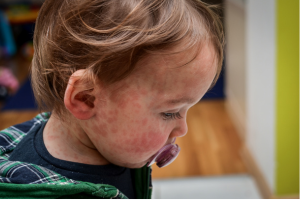Measles in children is mainly eradicated due to vaccination, even though it is a contagious viral illness. However, in areas with low vaccination rates, outbreaks can still occur. Dr. Bornstein will discuss practical insights into understanding the signs and symptoms, treatment, and prevention of measles.

DEFINITION:
A viral illness associated with specific symptoms and a rash. Also known as rubeola
SYMPTOMS:
The first sign of symptoms
- Cough
- Coryza (runny nose)
- Conjunctivitis (pink eye) are the three C’s of measles
These occur with
- fever to over 104 degrees
Then
- Koplik spots. Koplik spots are grayish-white dots surrounded by redness in the mouth. Koplik spots are a definite sign of measles.
- The next step in the progression of the illness is the occurrence of the rash. This rash starts behind the neck, goes over the head, down the face, and down the body. Fever over 104 degrees can occur with this rash. The rash is described as maculopapular, meaning large and small red spots.
CAUSES:
Caused by a virus.
CONTAGION:
Measles is contagious throughout the illness by respiratory transmission. The incubation period is 10 to 14 days.
DIAGNOSIS:
The symptoms that the child is experiencing are usually helpful in making a diagnosis. The doctor can order a blood test to confirm the diagnosis, but it is rarely needed.
OUTCOME:
Usually good. There is a death rate of 1 to 2 for every 1,000 cases. Death is usually due to complications, such as pneumonia or overwhelming bacterial superinfection. With vaccination, it is doubtful that someone would contract measles.
TREATMENT AND DISCUSSION:
Measles used to be a common occurrence in pediatrics before the days of vaccination. Since vaccination, this disease has become very rare. However, the disease can still be contracted due to missed vaccinations or objections. Vaccination is about 95% effective. As time progresses, the measles virus is slowly being eradicated. In susceptible individuals, about 90% will contract the illness if exposed. The illness is contracted by exposure to respiratory droplets (coughing and sneezing) from an infected individual.
Measles then follows three stages:
- Incubation Stage – Lasts about 14 days
- Prodromal Stage – Lasts about five days and includes the Three C’s of Measles: Cough, Coryza, Conjunctivitis
- Maculopapular Rash Stage – Lasts about 7-10 days
There is no treatment for measles since a virus causes this illness. Without complications, the disease will follow its natural course and disappear. If there are complications, treatment can be started. Treatment can include oxygen if pneumonia develops or antibiotics if a bacterial superinfection occurs. Encephalitis, or swelling of the brain, can occur with measles. There is no specific treatment for this.
Vitamin A has been found to help lessen complications in children with measles, and this can be given in confirmed cases.
The best treatment for measles is prevention through vaccination. The MMR vaccine is given at one year of age, and a booster dose is given at 4 to 6 years of age, although the second dose can be given at any time during childhood as long as one month has passed since the first vaccine. The measles vaccine can be given during an outbreak as early as six months of age. Measles immune globulin can be used to prevent contracting the illness and can be given up to 6 days after exposure for susceptible children. This is usually used in children with an immunosuppressive disease, where measles could be devastating. Nothing is needed for children under six months old since the mother’s immunity to measles protects the child from birth to 6 months of age.
ONE DOCTOR’S OPINION:
Vaccinate, vaccinate, vaccinate. The only way to wipe this virus off the face of the earth is to vaccinate. Medicine eradicated natural smallpox through vaccination. Eradication is getting very close for measles. Since measles is a virus, there really is no good treatment. Most children will survive, but some won’t. Outbreaks still occur, and it always seems to be in communities with a low vaccination rate. People don’t fear measles like they should and like they used to because not many people see it anymore (due to proper vaccination). Some people unfoundedly fear vaccination more than they fear the devastating illnesses that vaccines prevent. My advice? Vaccinate your children.
This blog was written by Dr. Michael Bornstein, who has 30 years of experience as a pediatrician.
Disclaimer: The contents of this article, including text and images, are for informational purposes only and do not constitute a medical service. Please note that all images belong to their original owners. Always seek the advice of a physician or other qualified health professional for medical advice, diagnosis, and treatment.


FOLLOW US